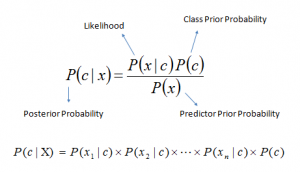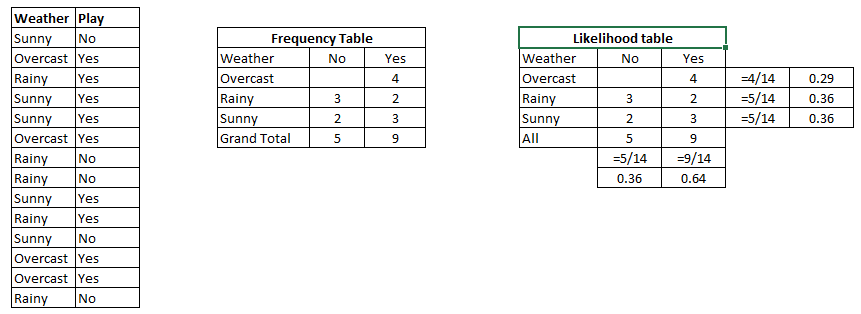6 Easy Steps to Learn Naive Bayes Algorithm (with code in Python)
来源:互联网 发布:淘宝与03年的非典 编辑:程序博客网 时间:2024/04/29 11:28
Introduction
Here’s a situation you’ve got into:
You are working on a classification problem and you have generated your set of hypothesis, created features and discussed the importance of variables. Within an hour, stakeholders want to see the first cut of the model.
What will you do? You have hunderds of thousands of data points and quite a few variables in your training data set. In such situation, if I were at your place, I would have used ‘Naive Bayes‘, which can be extremely fast relative to other classification algorithms. It works on Bayes theorem of probability to predict the class of unknown data set.
In this article, I’ll explain the basics of this algorithm, so that next time when you come across large data sets, you can bring this algorithm to action. In addition, if you are a newbie in Python, you should be overwhelmed by the presence of available codes in this article.

Table of Contents
- What is Naive Bayes algorithm?
- How Naive Bayes Algorithms works?
- What are the Pros and Cons of using Naive Bayes?
- 4 Applications of Naive Bayes Algorithm
- Steps to build a basic Naive Bayes Model in Python
- Tips to improve the power of Naive Bayes Model
What is Naive Bayes algorithm?
It is a classification technique based on Bayes’ Theorem with an assumption of independence among predictors. In simple terms, a Naive Bayes classifier assumes that the presence of a particular feature in a class is unrelated to the presence of any other feature. For example, a fruit may be considered to be an apple if it is red, round, and about 3 inches in diameter. Even if these features depend on each other or upon the existence of the other features, all of these properties independently contribute to the probability that this fruit is an apple and that is why it is known as ‘Naive’.
Naive Bayes model is easy to build and particularly useful for very large data sets. Along with simplicity, Naive Bayes is known to outperform even highly sophisticated classification methods.
Bayes theorem provides a way of calculating posterior probability P(c|x) from P(c), P(x) and P(x|c). Look at the equation below:
 Above,
Above,
- P(c|x) is the posterior probability of class (c, target) given predictor (x, attributes).
- P(c) is the prior probability of class.
- P(x|c) is the likelihood which is the probability of predictor given class.
- P(x) is the prior probability of predictor.
How Naive Bayes algorithm works?
Let’s understand it using an example. Below I have a training data set of weather and corresponding target variable ‘Play’ (suggesting possibilities of playing). Now, we need to classify whether players will play or not based on weather condition. Let’s follow the below steps to perform it.
Step 1: Convert the data set into a frequency table
Step 2: Create Likelihood table by finding the probabilities like Overcast probability = 0.29 and probability of playing is 0.64.

Step 3: Now, use Naive Bayesian equation to calculate the posterior probability for each class. The class with the highest posterior probability is the outcome of prediction.
Problem: Players will play if weather is sunny. Is this statement is correct?
We can solve it using above discussed method of posterior probability.
P(Yes | Sunny) = P( Sunny | Yes) * P(Yes) / P (Sunny)
Here we have P (Sunny |Yes) = 3/9 = 0.33, P(Sunny) = 5/14 = 0.36, P( Yes)= 9/14 = 0.64
Now, P (Yes | Sunny) = 0.33 * 0.64 / 0.36 = 0.60, which has higher probability.
Naive Bayes uses a similar method to predict the probability of different class based on various attributes. This algorithm is mostly used in text classification and with problems having multiple classes.
What are the Pros and Cons of Naive Bayes?
Pros:
- It is easy and fast to predict class of test data set. It also perform well in multi class prediction
- When assumption of independence holds, a Naive Bayes classifier performs better compare to other models like logistic regression and you need less training data.
- It perform well in case of categorical input variables compared to numerical variable(s). For numerical variable, normal distribution is assumed (bell curve, which is a strong assumption).
Cons:
- If categorical variable has a category (in test data set), which was not observed in training data set, then model will assign a 0 (zero) probability and will be unable to make a prediction. This is often known as “Zero Frequency”. To solve this, we can use the smoothing technique. One of the simplest smoothing techniques is called Laplace estimation.
- On the other side naive Bayes is also known as a bad estimator, so the probability outputs frompredict_proba are not to be taken too seriously.
- Another limitation of Naive Bayes is the assumption of independent predictors. In real life, it is almost impossible that we get a set of predictors which are completely independent.
4 Applications of Naive Bayes Algorithms
- Real time Prediction: Naive Bayes is an eager learning classifier and it is sure fast. Thus, it could be used for making predictions in real time.
- Multi class Prediction: This algorithm is also well known for multi class prediction feature. Here we can predict the probability of multiple classes of target variable.
- Text classification/ Spam Filtering/ Sentiment Analysis: Naive Bayes classifiers mostly used in text classification (due to better result in multi class problems and independence rule) have higher success rate as compared to other algorithms. As a result, it is widely used in Spam filtering (identify spam e-mail) and Sentiment Analysis (in social media analysis, to identify positive and negative customer sentiments)
- Recommendation System: Naive Bayes Classifier and Collaborative Filtering together builds a Recommendation System that uses machine learning and data mining techniques to filter unseen information and predict whether a user would like a given resource or not
How to build a basic model using Naive Bayes in Python?
Again, scikit learn (python library) will help here to build a Naive Bayes model in Python. There are three types of Naive Bayes model under scikit learn library:
Gaussian: It is used in classification and it assumes that features follow a normal distribution.
Multinomial: It is used for discrete counts. For example, let’s say, we have a text classification problem. Here we can consider bernoulli trials which is one step further and instead of “word occurring in the document”, we have “count how often word occurs in the document”, you can think of it as “number of times outcome number x_i is observed over the n trials”.
Bernoulli: The binomial model is useful if your feature vectors are binary (i.e. zeros and ones). One application would be text classification with ‘bag of words’ model where the 1s & 0s are “word occurs in the document” and “word does not occur in the document” respectively.
Based on your data set, you can choose any of above discussed model. Below is the example of Gaussian model.
Python Code
#Import Library of Gaussian Naive Bayes modelfrom sklearn.naive_bayes import GaussianNBimport numpy as np#assigning predictor and target variablesx= np.array([[-3,7],[1,5], [1,2], [-2,0], [2,3], [-4,0], [-1,1], [1,1], [-2,2], [2,7], [-4,1], [-2,7]])Y = np.array([3, 3, 3, 3, 4, 3, 3, 4, 3, 4, 4, 4])
#Create a Gaussian Classifiermodel = GaussianNB()# Train the model using the training sets model.fit(x, y)#Predict Output predicted= model.predict([[1,2],[3,4]])print predictedOutput: ([3,4])
Above, we looked at the basic Naive Bayes model, you can improve the power of this basic model by tuning parameters and handle assumption intelligently. Let’s look at the methods to improve the performance of Naive Bayes Model. I’d recommend you to go through this document for more details on Text classification using Naive Bayes.
Tips to improve the power of Naive Bayes Model
Here are some tips for improving power of Naive Bayes Model:
- If continuous features do not have normal distribution, we should use transformation or different methods to convert it in normal distribution.
- If test data set has zero frequency issue, apply smoothing techniques “Laplace Correction” to predict the class of test data set.
- Remove correlated features, as the highly correlated features are voted twice in the model and it can lead to over inflating importance.
- Naive Bayes classifiers has limited options for parameter tuning like alpha=1 for smoothing, fit_prior=[True|False] to learn class prior probabilities or not and some other options (look at detail here). I would recommend to focus on your pre-processing of data and the feature selection.
- You might think to apply some classifier combination technique like ensembling, bagging and boosting but these methods would not help. Actually, “ensembling, boosting, bagging” won’t help since their purpose is to reduce variance. Naive Bayes has no variance to minimize.
End Notes
In this article, we looked at one of the supervised machine learning algorithm “Naive Bayes” mainly used for classification. Congrats, if you’ve thoroughly & understood this article, you’ve already taken you first step to master this algorithm. From here, all you need is practice.
Further, I would suggest you to focus more on data pre-processing and feature selection prior to applying Naive Bayes algorithm.0 In future post, I will discuss about text and document classification using naive bayes in more detail.
Did you find this article helpful? Please share your opinions / thoughts in the comments section below.
转载于:http://www.analyticsvidhya.com/blog/2015/09/naive-bayes-explained/
- 6 Easy Steps to Learn Naive Bayes Algorithm (with code in Python)
- naive bayes with python
- 朴素贝叶斯 Naive Bayes in Python
- Learn Decorator Design Pattern in Easy Steps
- From APK to readable java source code in 3 easy steps
- Migrate to DB2 in Five Easy Steps
- Naive Bayes Classifier in OpenNLP
- Exercise 6: Naive Bayes
- 装饰设计模式 Learn Decorator Design Pattern in Easy Steps
- 朴素贝叶斯算法(naive Bayes algorithm)
- Scikit-learn——Naive Bayes
- Understanding Python Decorators in 12 Easy Steps!
- python - pytest - Very easy sample in steps
- Anyone Can Learn To Code an LSTM-RNN in Python
- From Java to Groovy in a few easy steps
- How to become an iPhone developer in eight easy steps
- How to write a Linux virus in 5 easy steps
- How To Defrag Your Mind In 5 Easy Steps
- 单例模式
- virutalbox相关问题20150405
- Java实现的文件切割器和文件合并器代码
- 在ubuntu上建立一个nginx代理邮件服务器20150405
- Objective-C学习-KVC(键值编码)和KVO(键值观察)
- 6 Easy Steps to Learn Naive Bayes Algorithm (with code in Python)
- mysql:Can’t create TCP/IP socket (10106)”
- 鼠标滑过弹出层
- Play Framework介绍:使用Eclipse开发和调试
- 各种类型占用字节数,以及内存分块20150908
- 爬取GEEKPARK最近一年活跃会员
- MySQL 性能调优的10个方法
- git设置HTTP代理
- C++优先级20150909


